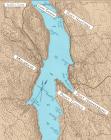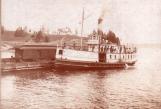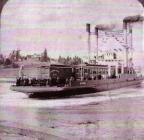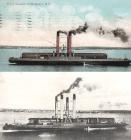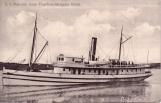2
EARLY FERRY SERVICE IN THE GUT OF CANSO - The Strait of Canso, separating Cape Breton Island from the mainland of Nova Scotia was always an obstacle for travellers and mail.Hugh MacMillan of Port Hastings was one of the prominent early ferry operators who operated as early as 1819 between Auld's Cove on the western side of the Strait of Canso and Port Hastings on the Cape Breton side. In 1829, he sent a letter of petition to the Provincial Legislature asking for his yearly operating grant to be increased, for the reason that "he has for these ten years kept a regular ferry operating in the Gut of Canso" but that he felt the need to expand was necessary. MacMillan wrote that "[in] these few years past, horses and other cattle to be ferried require boats suitable for such purposes" and after having purchased such boats, and keeping them in repair, the "yearly sum of six pounds... (is) inadequate to answer the expenses."
4
FERRYMEN IN THE STRAIT OF CANSO - By 1847, there were three ferry services crossing the Strait. They ran between Auld's Cove and Plaister Cove, Mulgrave and Port Hawkesbury, and Steep Creek and McPherson's Ferry. Each of the services had a small barge that would carry a horse and a wagon. That same year, Richard Carter of Steep Creek, Guysborough County, and David MacPherson of McPherson's Ferry, both received a grant of 10 pounds to operate their ferries.A 10 pound grant was awarded Isaiah Embree in 1857 to operate a ferry between Port Mulgrave and Ship Harbour (Port Hawkesbury).
5
SS EXPERIMENT & SS NORWEIGAN - The first steam ferry was the S.S. Experiment in 1860. It was Albert McBean who received a provincial grant of 750 pounds to start this service. It operated twice daily between Ship Harbour (Port Hawkesbury), Port Mulgrave, Plaister Cove (Port Hastings) and Auld's Cove.In 1880, the Cape Breton Railway Co. began operating the SS Norwegian between Wyld's Wharf in Mulgrave and Grant's Wharf in Port Hawkesbury. Five years later, the company built a winter dock at Point Tupper and picked up the contract for delivery of mail.
In the years leading up to 20th century, private ferry service continued to thrive, with the services being fine tuned to serve the area.
7
THE EVOLUTION OF TRAIN FERRIES - The era of the sailing ships was declining as the railway development progressed coming as far as Mulgrave on mainland Nova Scotia in 1880. Ten years later, the railway would be completed on Cape Breton Island between Point Tupper and Sydney. By 1893, the rail connection between mainland Nova Scotia and Cape Breton Island was made by the S.S. Mulgrave, a steam ship powerful enough to move a nine car passenger train on a scow.Mulgrave resident and rail ferry employee Hiram Crittenden spoke of the Mulgrave in a 1979 interview with Cape Breton's Magazine."She looked just like a passenger boat. She used to tow a scow. The train cars would go aboard tracks on the scow. I think she carried 3 passenger cars and probably 3 or 4 small freight cars. The load would only be small. Then the Mulgrave would hook onto the side of that scow, and she'd weather that thing over through the ice nearly all the winter".
9
FIRST SELF PROPELLED TRAIN FERRY - The Scotia, the first self propelled train ferry to operate in the Strait of Canso, is seen here in 1902 leaving Port Mulgrave. Built in England, it was a coal-fired vessel.Hiram Crittenden told Cape Breton's Magazine about the different types of coal used to drive the Scotia."Those boats, when they came here, had Welsh coal aboard of her. Well, you couldn't get anything better for steaming. It was lovely coal. Then they got using the Cape Breton coal. The Old Sydney coal was the best coal that ever Canada put out. Old Sydney coal, that was the name of the mine. And then they got around to the Bras d'Or coal and the Inverness coal. Well, Inverness coal was lovely steaming coal because I know it, I've used lots of it and know what it is. But it was bad for ashes. But no trouble to steam with the Inverness coal".
10
Ice in Strait of Canso.. ferry approaching Port Hawkesbury.1950
Strait of Canso, Nova Scotia, Canada
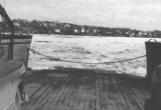
11
Earle Embree, son of ferryman James Embree, explained problems with crossing in winter in an interview with Cape Breton's Magazine.".....There was just a stream of ice in the centre of the Strait going to the southward for four hours, and when the tide would turn, it would run to the north for four hours. .....
Although the train ferries were heavier and able to absorb the impact of the ice and continued to cross in the winter, there were many times when they had problems with the ice".
Hiram Crittenden discussed these problems in an interview with Cape Breton's Magazine.
"One morning, I saw the ice grab the Scotia and take her way down the Strait and she didn't get back till 3 o'clock in the afternoon. That's from early morning. You could never plan on getting across [on schedule]."
13
WORKING ON THE FERRIES - Working in the depths of the coal-powered train ferries, the Scotia and later,Scotia II, Mulgrave's Hiram Crittenden recalled the tough working conditions he and the other men on the crew faced in an interview with Ron Caplan of the Cape Breton's Magazine."The heat down there - oh my God, she was cruel. I've come home here in the morning, about 6 o'clock, and wearing something heavy on your feet you know, and my boots would be white with the salt out of my body. I used to tell the boys, people would wonder if we had our right senses, to work down there. And you couldn't see anything. Someone would come down now and then, tell us where we were. Say, for instance, We'll just get by this ice pan and we'll be all right."

